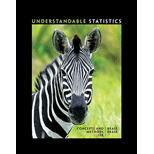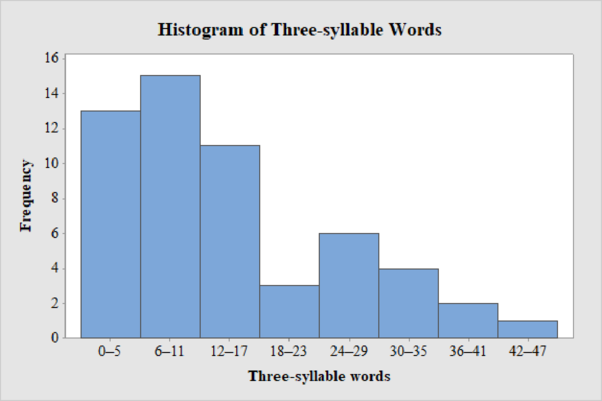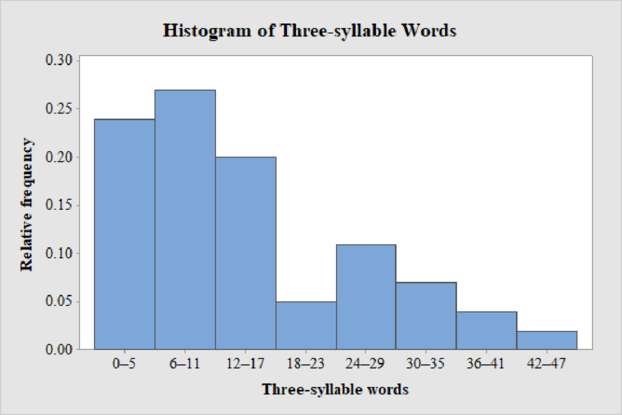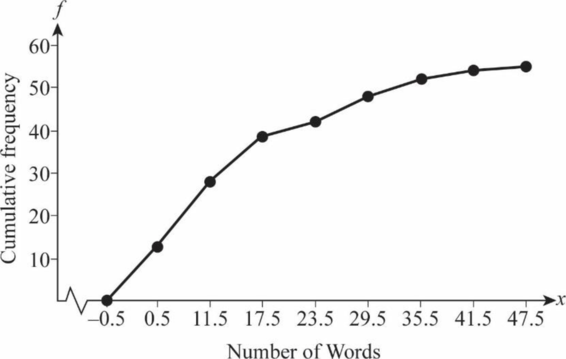
a.
Calculate the class width for the data on count of three-syllable words in advertising copy of magazine advertisements.
a.
Answer to Problem 20P
The class width is calculated as 6.
Explanation of Solution
Calculation:
From the given data set, the largest data point is 43 and the smallest data point is 0.
Class Width:
The class width is calculated as follows:
b.
Create a table for frequency distribution with class limits, class boundaries, midpoints, frequencies, relative frequencies, and cumulative frequencies.
b.
Answer to Problem 20P
The class limits for a frequency table with 8 classes using class width 6 are 0-5, 6-11, 12-17, 18-23, 24-29, 30-35, 36-41, and 42-47.
Explanation of Solution
Class limits:
Class limits are the maximum and minimum values in the class interval
Class Boundaries:
A class boundary is the midpoint between the upper limit of one class and the lower limit of the next class where the upper limit of the preceding class interval and the lower limit of the next class interval will be equal. The upper class boundary is calculated by adding 0.5 to the upper class limit and the lower class boundary is calculated by subtracting 0.5 from the lower class limit.
Midpoint:
The midpoint is calculated as given below:
Frequency:
Frequency is the number of data points that fall under each class.
Cumulative frequency:
Cumulative frequency is calculated by adding each frequency to the sum of preceding frequencies.
Relative Frequency:
Relative frequency is the ratio of frequency by the total number of data values.
The class width is 6. Hence, the lower class limit for the second class 6 is calculated by adding 6 to 0. Following this pattern, all the lower class limits are established. Then, the upper class limits are calculated.
The frequency distribution table is given below:
| Class Limits | Class Boundaries | Midpoints | Frequency | Relative Frequency | Cumulative Frequency |
| 0-5 | 0.5-5.5 |
2.5 | 13 | 13 | |
| 6-11 | 5.5-11.5 | 8.5 | 15 | 28 (=15+13) | |
| 12-17 | 11.5-17.5 | 14.5 | 11 | 39 (=11+28) | |
| 18-23 | 17.5-23.5 | 20.5 | 3 | 42 (=3+39) | |
| 24-29 | 23.5-29.5 | 26.5 | 6 | 48 (=6+42) | |
| 30-35 | 29.5-35.5 | 32.5 | 4 | 52 (=4+48) | |
| 36-41 | 35.5-41.5 | 38.5 | 2 | 54 (=2+52) | |
| 42-47 | 41.5-47.5 | 44.5 | 1 | 55 (=1+54) |
c.
Create a histogram for the given data on count of three-syllable words in advertising copy of magazine advertisements.
c.
Answer to Problem 20P
The frequency histogram for the data on count of three-syllable words in advertising copy of magazine advertisements is shown below:

Explanation of Solution
Step-by-step procedure to draw the histogram using MINITAB software:
- Choose Graph > Bar Chart.
- From Bars represent, choose Values from a table.
- Under One column of values, choose Simple. Click OK.
- In Graph variables, enter the column of Frequency.
- In Categorical variables, enter the column of Three-syllable Words.
- Click OK.
Thus, the histogram for three-syllable word data is obtained.
d.
Construct a relative frequency histogram for the data on count of three-syllable words in advertising copy of magazine advertisements.
d.
Answer to Problem 20P
The relative frequency histogram for the data on count of three-syllable words in advertising copy of magazine advertisements is shown below:

Explanation of Solution
Step-by-step procedure to draw the histogram using MINITAB software:
- Choose Graph > Bar Chart.
- From Bars represent, choose Values from a table.
- Under One column of values, choose Simple. Click OK.
- In Graph variables, enter the column of Relative frequency.
- In Categorical variables, enter the column of Three-syllable Words.
- Click OK.
Thus, the relative frequency histogram for three-syllable word data is obtained.
e.
Identify the shape of distribution: uniform, mound shaped, symmetric, bimodal, skewed left, or skewed right.
e.
Explanation of Solution
From the histogram, the distribution of count of three-syllable words in advertising copy of magazine advertisements is skewed to the right.
f.
Create an ogive curve for the given data on count of three-syllable words in advertising copy of magazine advertisements.
f.
Answer to Problem 20P
An ogive curve for the count of three-syllable words in advertising copy of magazine advertisements is shown below:

Explanation of Solution
Step-by-step procedure to draw the Ogive curve:
- Draw X axis with data values ranging from -0.5 to 47.5.
- Label the X axis as Number of Words.
- Draw Y axis with data values Cumulative frequency ranging from.0 to 60.
- Label the Y axis as Cumulative frequency.
- Plot the cumulative frequencies
- Join the points and draw an ogive curve.
Thus, an ogive curve for three-syllable word data is obtained.
g.
Identify the characteristics about the count of three-syllable words in advertising copy of magazine advertisements using the graphs.
g.
Explanation of Solution
The data values of count of three-syllable words in advertising copy of magazine advertisements fall within 0 and 43.
The
The central value of the data is approximately 11.5.
From the histogram, it can be observed that the data is skewed to the right and there are no unusual observations in the data as not even one data point is far from the overall bulk of data.
Want to see more full solutions like this?
Chapter 2 Solutions
Understandable Statistics: Concepts and Methods
 Holt Mcdougal Larson Pre-algebra: Student Edition...AlgebraISBN:9780547587776Author:HOLT MCDOUGALPublisher:HOLT MCDOUGAL
Holt Mcdougal Larson Pre-algebra: Student Edition...AlgebraISBN:9780547587776Author:HOLT MCDOUGALPublisher:HOLT MCDOUGAL Glencoe Algebra 1, Student Edition, 9780079039897...AlgebraISBN:9780079039897Author:CarterPublisher:McGraw Hill
Glencoe Algebra 1, Student Edition, 9780079039897...AlgebraISBN:9780079039897Author:CarterPublisher:McGraw Hill Functions and Change: A Modeling Approach to Coll...AlgebraISBN:9781337111348Author:Bruce Crauder, Benny Evans, Alan NoellPublisher:Cengage Learning
Functions and Change: A Modeling Approach to Coll...AlgebraISBN:9781337111348Author:Bruce Crauder, Benny Evans, Alan NoellPublisher:Cengage Learning Big Ideas Math A Bridge To Success Algebra 1: Stu...AlgebraISBN:9781680331141Author:HOUGHTON MIFFLIN HARCOURTPublisher:Houghton Mifflin Harcourt
Big Ideas Math A Bridge To Success Algebra 1: Stu...AlgebraISBN:9781680331141Author:HOUGHTON MIFFLIN HARCOURTPublisher:Houghton Mifflin Harcourt



